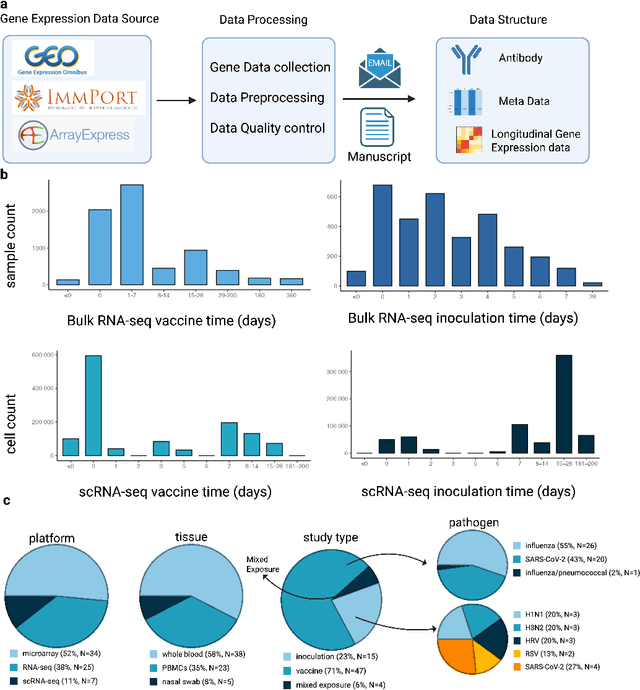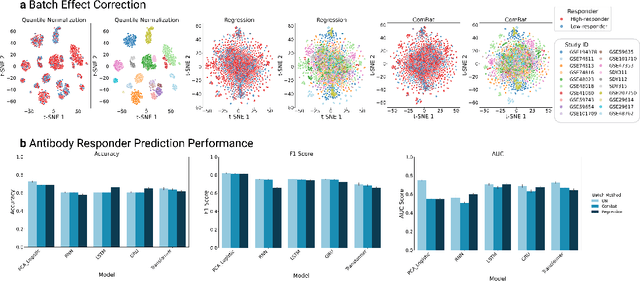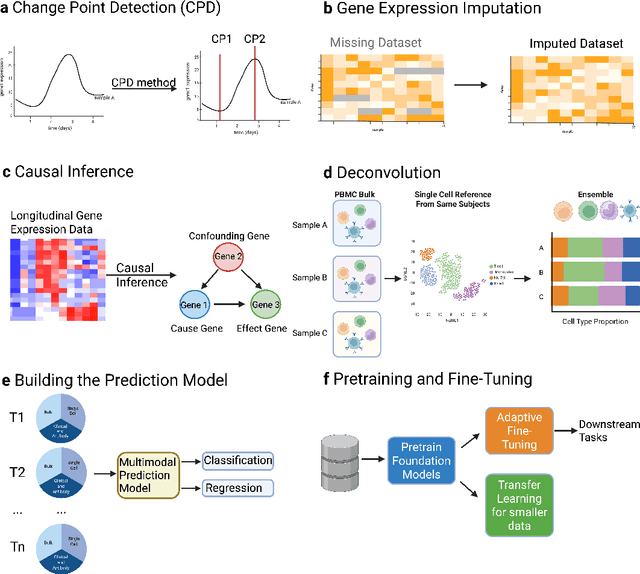Xinyi Li
GUIDES: Guidance Using Instructor-Distilled Embeddings for Pre-trained Robot Policy Enhancement
Nov 05, 2025Abstract:Pre-trained robot policies serve as the foundation of many validated robotic systems, which encapsulate extensive embodied knowledge. However, they often lack the semantic awareness characteristic of foundation models, and replacing them entirely is impractical in many situations due to high costs and the loss of accumulated knowledge. To address this gap, we introduce GUIDES, a lightweight framework that augments pre-trained policies with semantic guidance from foundation models without requiring architectural redesign. GUIDES employs a fine-tuned vision-language model (Instructor) to generate contextual instructions, which are encoded by an auxiliary module into guidance embeddings. These embeddings are injected into the policy's latent space, allowing the legacy model to adapt to this new semantic input through brief, targeted fine-tuning. For inference-time robustness, a large language model-based Reflector monitors the Instructor's confidence and, when confidence is low, initiates a reasoning loop that analyzes execution history, retrieves relevant examples, and augments the VLM's context to refine subsequent actions. Extensive validation in the RoboCasa simulation environment across diverse policy architectures shows consistent and substantial improvements in task success rates. Real-world deployment on a UR5 robot further demonstrates that GUIDES enhances motion precision for critical sub-tasks such as grasping. Overall, GUIDES offers a practical and resource-efficient pathway to upgrade, rather than replace, validated robot policies.
Clone Deterministic 3D Worlds with Geometrically-Regularized World Models
Oct 30, 2025Abstract:A world model is an internal model that simulates how the world evolves. Given past observations and actions, it predicts the future of both the embodied agent and its environment. Accurate world models are essential for enabling agents to think, plan, and reason effectively in complex, dynamic settings. Despite rapid progress, current world models remain brittle and degrade over long horizons. We argue that a central cause is representation quality: exteroceptive inputs (e.g., images) are high-dimensional, and lossy or entangled latents make dynamics learning unnecessarily hard. We therefore ask whether improving representation learning alone can substantially improve world-model performance. In this work, we take a step toward building a truly accurate world model by addressing a fundamental yet open problem: constructing a model that can fully clone and overfit to a deterministic 3D world. We propose Geometrically-Regularized World Models (GRWM), which enforces that consecutive points along a natural sensory trajectory remain close in latent representation space. This approach yields significantly improved latent representations that align closely with the true topology of the environment. GRWM is plug-and-play, requires only minimal architectural modification, scales with trajectory length, and is compatible with diverse latent generative backbones. Across deterministic 3D settings and long-horizon prediction tasks, GRWM significantly increases rollout fidelity and stability. Analyses show that its benefits stem from learning a latent manifold with superior geometric structure. These findings support a clear takeaway: improving representation learning is a direct and useful path to robust world models, delivering reliable long-horizon predictions without enlarging the dynamics module.
TITAN: A Trajectory-Informed Technique for Adaptive Parameter Freezing in Large-Scale VQE
Sep 18, 2025



Abstract:Variational quantum Eigensolver (VQE) is a leading candidate for harnessing quantum computers to advance quantum chemistry and materials simulations, yet its training efficiency deteriorates rapidly for large Hamiltonians. Two issues underlie this bottleneck: (i) the no-cloning theorem imposes a linear growth in circuit evaluations with the number of parameters per gradient step; and (ii) deeper circuits encounter barren plateaus (BPs), leading to exponentially increasing measurement overheads. To address these challenges, here we propose a deep learning framework, dubbed Titan, which identifies and freezes inactive parameters of a given ansatze at initialization for a specific class of Hamiltonians, reducing the optimization overhead without sacrificing accuracy. The motivation of Titan starts with our empirical findings that a subset of parameters consistently has a negligible influence on training dynamics. Its design combines a theoretically grounded data construction strategy, ensuring each training example is informative and BP-resilient, with an adaptive neural architecture that generalizes across ansatze of varying sizes. Across benchmark transverse-field Ising models, Heisenberg models, and multiple molecule systems up to 30 qubits, Titan achieves up to 3 times faster convergence and 40% to 60% fewer circuit evaluations than state-of-the-art baselines, while matching or surpassing their estimation accuracy. By proactively trimming parameter space, Titan lowers hardware demands and offers a scalable path toward utilizing VQE to advance practical quantum chemistry and materials science.
Marine Chlorophyll Prediction and Driver Analysis based on LSTM-RF Hybrid Models
Aug 07, 2025Abstract:Marine chlorophyll concentration is an important indicator of ecosystem health and carbon cycle strength, and its accurate prediction is crucial for red tide warning and ecological response. In this paper, we propose a LSTM-RF hybrid model that combines the advantages of LSTM and RF, which solves the deficiencies of a single model in time-series modelling and nonlinear feature portrayal. Trained with multi-source ocean data(temperature, salinity, dissolved oxygen, etc.), the experimental results show that the LSTM-RF model has an R^2 of 0.5386, an MSE of 0.005806, and an MAE of 0.057147 on the test set, which is significantly better than using LSTM (R^2 = 0.0208) and RF (R^2 =0.4934) alone , respectively. The standardised treatment and sliding window approach improved the prediction accuracy of the model and provided an innovative solution for high-frequency prediction of marine ecological variables.
Geometric Operator Learning with Optimal Transport
Jul 26, 2025Abstract:We propose integrating optimal transport (OT) into operator learning for partial differential equations (PDEs) on complex geometries. Classical geometric learning methods typically represent domains as meshes, graphs, or point clouds. Our approach generalizes discretized meshes to mesh density functions, formulating geometry embedding as an OT problem that maps these functions to a uniform density in a reference space. Compared to previous methods relying on interpolation or shared deformation, our OT-based method employs instance-dependent deformation, offering enhanced flexibility and effectiveness. For 3D simulations focused on surfaces, our OT-based neural operator embeds the surface geometry into a 2D parameterized latent space. By performing computations directly on this 2D representation of the surface manifold, it achieves significant computational efficiency gains compared to volumetric simulation. Experiments with Reynolds-averaged Navier-Stokes equations (RANS) on the ShapeNet-Car and DrivAerNet-Car datasets show that our method achieves better accuracy and also reduces computational expenses in terms of both time and memory usage compared to existing machine learning models. Additionally, our model demonstrates significantly improved accuracy on the FlowBench dataset, underscoring the benefits of employing instance-dependent deformation for datasets with highly variable geometries.
DSAGL: Dual-Stream Attention-Guided Learning for Weakly Supervised Whole Slide Image Classification
May 29, 2025Abstract:Whole-slide images (WSIs) are critical for cancer diagnosis due to their ultra-high resolution and rich semantic content. However, their massive size and the limited availability of fine-grained annotations pose substantial challenges for conventional supervised learning. We propose DSAGL (Dual-Stream Attention-Guided Learning), a novel weakly supervised classification framework that combines a teacher-student architecture with a dual-stream design. DSAGL explicitly addresses instance-level ambiguity and bag-level semantic consistency by generating multi-scale attention-based pseudo labels and guiding instance-level learning. A shared lightweight encoder (VSSMamba) enables efficient long-range dependency modeling, while a fusion-attentive module (FASA) enhances focus on sparse but diagnostically relevant regions. We further introduce a hybrid loss to enforce mutual consistency between the two streams. Experiments on CIFAR-10, NCT-CRC, and TCGA-Lung datasets demonstrate that DSAGL consistently outperforms state-of-the-art MIL baselines, achieving superior discriminative performance and robustness under weak supervision.
HR-VILAGE-3K3M: A Human Respiratory Viral Immunization Longitudinal Gene Expression Dataset for Systems Immunity
May 19, 2025



Abstract:Respiratory viral infections pose a global health burden, yet the cellular immune responses driving protection or pathology remain unclear. Natural infection cohorts often lack pre-exposure baseline data and structured temporal sampling. In contrast, inoculation and vaccination trials generate insightful longitudinal transcriptomic data. However, the scattering of these datasets across platforms, along with inconsistent metadata and preprocessing procedure, hinders AI-driven discovery. To address these challenges, we developed the Human Respiratory Viral Immunization LongitudinAl Gene Expression (HR-VILAGE-3K3M) repository: an AI-ready, rigorously curated dataset that integrates 14,136 RNA-seq profiles from 3,178 subjects across 66 studies encompassing over 2.56 million cells. Spanning vaccination, inoculation, and mixed exposures, the dataset includes microarray, bulk RNA-seq, and single-cell RNA-seq from whole blood, PBMCs, and nasal swabs, sourced from GEO, ImmPort, and ArrayExpress. We harmonized subject-level metadata, standardized outcome measures, applied unified preprocessing pipelines with rigorous quality control, and aligned all data to official gene symbols. To demonstrate the utility of HR-VILAGE-3K3M, we performed predictive modeling of vaccine responders and evaluated batch-effect correction methods. Beyond these initial demonstrations, it supports diverse systems immunology applications and benchmarking of feature selection and transfer learning algorithms. Its scale and heterogeneity also make it ideal for pretraining foundation models of the human immune response and for advancing multimodal learning frameworks. As the largest longitudinal transcriptomic resource for human respiratory viral immunization, it provides an accessible platform for reproducible AI-driven research, accelerating systems immunology and vaccine development against emerging viral threats.
Wireless Large AI Model: Shaping the AI-Native Future of 6G and Beyond
Apr 20, 2025Abstract:The emergence of sixth-generation and beyond communication systems is expected to fundamentally transform digital experiences through introducing unparalleled levels of intelligence, efficiency, and connectivity. A promising technology poised to enable this revolutionary vision is the wireless large AI model (WLAM), characterized by its exceptional capabilities in data processing, inference, and decision-making. In light of these remarkable capabilities, this paper provides a comprehensive survey of WLAM, elucidating its fundamental principles, diverse applications, critical challenges, and future research opportunities. We begin by introducing the background of WLAM and analyzing the key synergies with wireless networks, emphasizing the mutual benefits. Subsequently, we explore the foundational characteristics of WLAM, delving into their unique relevance in wireless environments. Then, the role of WLAM in optimizing wireless communication systems across various use cases and the reciprocal benefits are systematically investigated. Furthermore, we discuss the integration of WLAM with emerging technologies, highlighting their potential to enable transformative capabilities and breakthroughs in wireless communication. Finally, we thoroughly examine the high-level challenges hindering the practical implementation of WLAM and discuss pivotal future research directions.
LL-Localizer: A Life-Long Localization System based on Dynamic i-Octree
Apr 02, 2025



Abstract:This paper proposes an incremental voxel-based life-long localization method, LL-Localizer, which enables robots to localize robustly and accurately in multi-session mode using prior maps. Meanwhile, considering that it is difficult to be aware of changes in the environment in the prior map and robots may traverse between mapped and unmapped areas during actual operation, we will update the map when needed according to the established strategies through incremental voxel map. Besides, to ensure high performance in real-time and facilitate our map management, we utilize Dynamic i-Octree, an efficient organization of 3D points based on Dynamic Octree to load local map and update the map during the robot's operation. The experiments show that our system can perform stable and accurate localization comparable to state-of-the-art LIO systems. And even if the environment in the prior map changes or the robots traverse between mapped and unmapped areas, our system can still maintain robust and accurate localization without any distinction. Our demo can be found on Blibili (https://www.bilibili.com/video/BV1faZHYCEkZ) and youtube (https://youtu.be/UWn7RCb9kA8) and the program will be available at https://github.com/M-Evanovic/LL-Localizer.
BEV-LIO(LC): BEV Image Assisted LiDAR-Inertial Odometry with Loop Closure
Feb 26, 2025Abstract:This work introduces BEV-LIO(LC), a novel LiDAR-Inertial Odometry (LIO) framework that combines Bird's Eye View (BEV) image representations of LiDAR data with geometry-based point cloud registration and incorporates loop closure (LC) through BEV image features. By normalizing point density, we project LiDAR point clouds into BEV images, thereby enabling efficient feature extraction and matching. A lightweight convolutional neural network (CNN) based feature extractor is employed to extract distinctive local and global descriptors from the BEV images. Local descriptors are used to match BEV images with FAST keypoints for reprojection error construction, while global descriptors facilitate loop closure detection. Reprojection error minimization is then integrated with point-to-plane registration within an iterated Extended Kalman Filter (iEKF). In the back-end, global descriptors are used to create a KD-tree-indexed keyframe database for accurate loop closure detection. When a loop closure is detected, Random Sample Consensus (RANSAC) computes a coarse transform from BEV image matching, which serves as the initial estimate for Iterative Closest Point (ICP). The refined transform is subsequently incorporated into a factor graph along with odometry factors, improving the global consistency of localization. Extensive experiments conducted in various scenarios with different LiDAR types demonstrate that BEV-LIO(LC) outperforms state-of-the-art methods, achieving competitive localization accuracy. Our code, video and supplementary materials can be found at https://github.com/HxCa1/BEV-LIO-LC.
 Add to Chrome
Add to Chrome Add to Firefox
Add to Firefox Add to Edge
Add to Edge